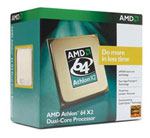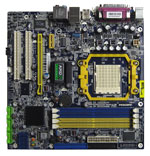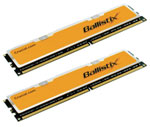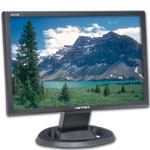AMD Entry-level PC
With few releases for the entry-level AMD market since our last
Budget Buyer's Guide, we have a very similar level of components - albeit with a doubling of RAM that should boost performance nicely in Vista. This boosted performance comes in at $100 cheaper than six months ago as well. Although that may not sound like much to an enthusiast gamer that can spend five times as much on a graphics card, for the budget computer users $100 is a 10% reduction in price. For businesses looking at upgrading hundreds or even thousands of computers, that sort of savings is even more significant, making now a great time to purchase AMD hardware.
| AMD Entry-level PC |
| Hardware |
Component |
Price |
Rebates |
| Processor |
AMD Athlon 64 X2 4000+
(2.1GHz 65W Brisbane 2 x 512KB L2) |
$66 |
- |
| Motherboard |
Foxconn A690GM2MA-8KRS2H
AMD 690G mATX |
$49 |
$20 |
| Memory |
Crucial Ballistix 2GB (2x1GB) DDR2-800 PC2-6400 |
$90 |
$40 |
| Hard Drive |
Samsung Spinpoint P Series SP2504C
250GB 7200RPM SATA 3.0GB/s |
$63 |
- |
| Optical Drive |
Samsung 20X DVDRW/DL SH-S202G |
$28 |
- |
| Case |
Athenatech A3602BB.400 mATX w/400W PSU |
$35 |
- |
| Display |
Hanns-G HW-191DPB Black 19" 5ms Widescreen DVI
(1440x900) |
$170 |
- |
| Speakers |
Logitech R-20 12W 2.1 |
$19 |
- |
| Input |
Microsoft Optical Desktop 1000 Wireless |
$26 |
- |
| Operating System |
Microsoft Vista Home Premium OEM |
$112 |
- |
| Bottom Line |
$658 |
$598 |
 |
Prices on AMD's dual-core processors are continuing to drop in the face of the continued, aggressive pricing strategy adopted by Intel. With the imminent launch of the desktop Phenom processor line, we should see prices bottom out as AMD tries to clear out their existing inventory of processors. The Athlon X2 4000+ is a great little chip for the price, now at around 1/3 the cost of what many paid for their dual-core Athlon chips 18 months ago. With the Athlon X2 3600+ saving us a total of just $3, there really isn't another low-end dual-core option from AMD worth considering.
If money is still a concern, we could drop the processor down to a single-core Athlon 64 3200+ (2.0GHz Orleans core) at $42.99 - a savings of $23. Another option is the Sempron LE-1100 based around AMD's Sparta core, which runs at 1.9GHz, has a power draw of just 45W, and a price of just $39.99 - great for the most basic of office PCs or for those looking to save on power consumption. However, our recommendation would be to spend a bit more on the CPU and go for a dual-core; there's no doubt that these will be a pre-requisite in the next few years as application demands increase.
 |
Choosing a motherboard can be one of the hardest decisions to make when building a new system, and is a particular concern when building within the budget/entry-level range. The theory that budget decreases result in compromised quality simply isn't true anymore - or at least it doesn't need to be the case; there are still some cheap, very poor quality motherboards out there. When building for a budget system, features, reliability, and stability should remain high on the list and the situation is continually improving - die shrinks of CPUs, IGPs, and chipsets all help to keep costs low as performance increases.
For the current situation, the AMD 690G with ATI's Radeon X1250 GPU chipset is still our frontrunner when choosing an entry-level AMD motherboard. The good news is that motherboards based on this chipset - and from reputable manufacturers - are available for under $50. Foxconn is one of the largest OEM suppliers in the world, producing everything from EVGA video cards to Apple MacBook/Pro motherboards and Sony PlayStation 3 mainboards. Their quality control has risen over the last few years and the somewhat long-winded A690GM2MA-8KRS2H has all the features you can find in competing motherboards, all at a significantly lower price.
 |
With DDR2 prices at their lowest point, we went for DDR2-800 this time - and managed to score 2GB of Crucial's high-performance Ballistix RAM for the same price as RAM from budget manufacturers. This particular line of RAM costs more than four times as much just six months ago, and presents an attractive alternative while providing a future-proof selection should you wish to ditch the onboard graphics, purchase a video card, and start gaming seriously. Granted, the $50 price involves a mail-in rebate, but for high-quality RAM it might be worth the hassle. If you prefer to avoid MIRs, nearly every major manufacturer has 2GB kits of DDR2-800 going for ~$50 give or take, so there are plenty of options available.
For the remaining items, we went with Samsung's SpinPoint hard drive series this time as availability has increased since our last roundup. The SpinPoint range is renowned for their reliability and silence, without sacrificing performance. Truth be told, while there are differences between hard drives, outside of running benchmarks most people aren't likely to notice the difference in performance. Western Digital, Seagate, and Hitachi are the other major brands, and all are worthy of consideration if the price is right.
The last major component to discuss is the display, and here we have to choose between standard aspect ratio (4:3) and widescreen (16:9). As far as we're concerned, the sooner 4:3 displays die out, the better.
(Ed: Maybe then EA will finally get with the program and include proper WS support!) Although standard aspect ratio displays have a slightly larger surface area, the quality of budget widescreen displays has risen this past year. With 19" displays regularly selling for under $200 - and usually for no more than a couple of dollars more than 17" displays - this display from Hanns-G represents fantastic value for money.














63 Comments
View All Comments
JarredWalton - Tuesday, November 13, 2007 - link
Don't forget the display! That adds about $200 if you use the display we selected, so you save a bit of money but get a smaller HDD (1/4 the size), a GPU that's not half as fast as the 8800 GT, and I'd use something other than the ASUS M2A-VM if you're going to have a discrete GPU in there. I'm a bit confused as to whether you were shooting for "budget" or "budget gaming".I try not to repeat stuff on every page, as I assume (possibly incorrectly) that people will read the article as a whole. We do mention the option to get a better PSU on the Intel Gaming page. The reality is, all the good PSUs start at around $60 (PCP&C 360W is $58 shipped). I figure you either get one of the 80% Energy Efficient Certified models, or go with whatever comes with your chosen case.
Hope that clarifies things a bit - we're not saying these systems are the *only* way to go right now, as individual needs will vary. If you're looking at gaming, though, I don't think I'd get anything less than the 8800 GT these days. You can cut corners elsewhere to your hearts content, but there are quite a few titles out that now require a lot of GPU power even at moderate resolutions. (Hellgate: London, for example, is pretty sluggish even on a single 8800 GTX! Same goes for the Crysis demo.)
Crassus - Friday, November 9, 2007 - link
Just as an aside - I remember frequent references to the Anandtech Real Time Pricing (labs.anandtech.com) in the old buyer's guides. That seems to have completely disappeared. I wanted to look up something there and I only get error messages, both in Firefox and IE. Is it me or is it you?phusg - Friday, November 9, 2007 - link
Thanks for the article. Just one grammatical mistake that really grates me:"Even though the Intel system comes in at a lower price" is fine.
"Even though the Intel system is cheaper" is fine.
is not!
Polizei - Friday, November 9, 2007 - link
Bravo, Bravo. I just wanted to say that I greatly appreciate this article. I'm an avid computer enthusiast and have followed Anandtech, HardOCP, and CPU magazine for years. That said, I've never felt it necessary to become involved in the forum thread posting until this article. Far too many websites seem to ignore the fact that stable, overclockable, affordable, and high-performing parts are available if someone needs to go that route. $2,000-$6,000 high-performance gaming systems are often regarded as a must-have for every enthusiast, which limits a great deal of modern society if they so choose to game, watch movies, or just want a faster computer. So again, my hat is off to you guys for finally stepping up and putting together a very good guide for lower-priced rigs that actually don't suck and crash every 5 minutes. Not sure if you follow competitors at all, but Maximum PC Magazine recently did a similar article and it was just atrocious as to how they approached it - http://www.maximumpc.com/article/the_500_pc_build_...">http://www.maximumpc.com/article/the_500_pc_build_...wjl - Friday, November 9, 2007 - link
First: the Intel CPUs mentioned here are not able to support hardware virtualization, which is a major issue for me. You have to get a Core 2 Duo 6xxx for that purpose, and they are still pretty more expensive than AMD's offerings, which all (except the low-end Sempron line) support VT-X (they call it Pacifica).Second: As mentioned here before, considering and testing compatibility with Linux is especially with the low budget model a major issue as well. Integrated Intel graphics would be better in that regard, because they open sourced most of their graphics drivers. For an AMD system, open source drivers will be coming, but at the moment those from nVidia should perform better - and you can select whether you want to use the free nv driver or the unsupported but free (as in beer) proprietary driver from nVidia.
Third: As of today, you should think a bit about the "green" factor. Most of todays CPUs are more than fast enough for any serious work we could throw at them, except maybe video processing. Selecting CPUs like the AMD BE series (with 45W max) or even lower level Intel chips (without virtualization capabilities, as mentioned before) should have been considered. There's also much to think about when it comes to power supplies and so on.
Maybe it's interesting to look at the "Solar PC", built from the guys over at Tom's Hardware in Munich? They ended up with a systems which consumes about 61W when idle - including the monitor! Of course, here Laptops really shine.
With low-cost NAS devices like the IcyBox (or MaPower) available, you could even have thought about thin clients or thin-client-like new offering like the Asus Eee PC (like Asus say, they are selling one each 6 seconds now). For 400$ or 300€, you'll get a neat little machine which can do most of what people want to do with their computers today. Add the same price for a RAID1 NAS, which can be shared within your household, and you'll have the perfect "green" setup.
kind regards,
wjl aka Wolfgang Lonien
(you'll find more thoughts from me on the topic on my pages in the interweb)
Calin - Friday, November 9, 2007 - link
Yes, the 800x480 pixels monitor on an Asus Eee will do great, especially in Windows with its fat themes (XP with default theme, Vista with default theme).Hardware virtualization might be a problem, though I hear it isn't much used for performance reasons.
Low power processors? All the way. By the way, you could get low power from a normal processor by undervolting (and maybe underclocking). Not sure if it's possible on the chosen mainboards.
wjl - Friday, November 9, 2007 - link
Who needs Windows to write a letter or surf the net? I hope that system will be history soon, like the dinosaurs...strikeback03 - Tuesday, November 13, 2007 - link
Considering that the average website these days is designed to target a minimum of 1024x768 resolution, surfing on a smaller screen can be a pain.tomoyo - Friday, November 9, 2007 - link
A gamer would never pick a 5ms TN-Film lcd. Those have a lot of ghosting issues compared to 2ms TN-films.tomoyo - Friday, November 9, 2007 - link
First of all, many components are completely unexplained. Second I dislike a number of the choices, the most major issue being the case/psu. Both case and psu picked are from very low quality makers. These are the types of psus that tend to explode with major load. They should never be recommended to users of anandtech. I'd like to see some more detailed research and explanations that go with a focus on good quality components, rather than trying to keep to some cutrate budget.